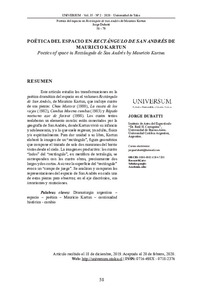Por favor, use este identificador para citar o enlazar este ítem:
https://repositorio.uca.edu.ar/handle/123456789/11452| Título: | Poética del espacio en rectángulo de San Andrés de Mauricio Kartun Poetics of space in rectángulo de San Andrés by Mauricio Kartun |
Autor: | Dubatti, Jorge | Palabras clave: | LITERATURA ARGENTINA; TEATRO ARGENTINO; Kartun, Mauricio, 1946-; ANALISIS LITERARIO; ESPACIO | Fecha de publicación: | 2020 | Editorial: | Universidad de Talca | Cita: | Dubatti, J. Poética del espacio en rectángulo de San Andrés de Mauricio Kartun [en línea]. Universum. Revista de Humanidades y Ciencias Sociales. 2020, 35 (2). Disponible en: https://repositorio.uca.edu.ar/handle/123456789/11452 | Resumen: | Resumen:
Este artículo estudia las transformaciones en la poética dramática del espacio en el volumen Rectángulo de San Andrés, de Mauricio Kartun, que incluye cuatro de sus piezas: Chau Misterix (1980), La casita de los viejos (1982), Cumbia Morena cumbia (1983) y Rápido nocturno aire de foxtrot (1998). Los cuatro textos reelaboran un elemento común: están conectados por la geografía de San Andrés, donde Kartun vivió su infancia y adolescencia, y a la que suele regresar, ya adulto, física y/o espiritualmente. Para dar unidad a su libro, Kartun elaboró la imagen de un “rectángulo”, figura geométrica que compone el trazado de solo dos manzanas del barrio vistas desde el cielo. La imagen es productiva: los cuatro “lados” del “rectángulo”, en metáfora de tetralogía, se corresponden con las cuatro obras, precisamente dos largas y dos cortas. A su vez la superficie del “rectángulo” evoca un “campo de juego”. Se analizan y comparan las representaciones del espacio de San Andrés en cada una de estas piezas para observar, en el eje diacrónico, sus invariantes y mutaciones. Abstract: This article studies the transformations in the dramatic poetics of space in the volume Rectángulo de San Andrés, by Mauricio Kartun, which includes four of his pieces: Chau Misterix (1980), La casita de los viejos (1982), Cumbia Morena cumbia (1983) and Rápido nocturno aire de foxtrot (1998). The four texts rework a common element: they are connected by the geography of San Andrés, where Kartun lived his childhood and adolescence, and to which he usually returns, already adult, physically and / or spiritually. To give unity to his book, Kartun drew up the image of a “rectangle”, a geometric figure that makes up the layout of only two blocks in the neighborhood seen from the sky. The image is productive: the four “sides” of the “rectangle”, in tetralogy’s metaphor, correspond to the four works, precisely two long and two short. In turn, the surface of the “rectangle” evokes a “playing field”. The representations of the space of San Andrés in each of these pieces are analyzed and compared to observe, in the diachronic axis, their invariants and mutations. |
URI: | https://repositorio.uca.edu.ar/handle/123456789/11452 | ISSN: | 0718-2376 (online) 0716-498X |
Disciplina: | LITERATURA | Derechos: | Acceso abierto | Fuente: | Universum. Revista de Humanidades y Ciencias Sociales Vol.35, No.2, 2020 |
| Aparece en las colecciones: | Artículos |
Ficheros en este ítem:
| Fichero | Descripción | Tamaño | Formato | |
|---|---|---|---|---|
| poetica-espacio-san-andres.pdf | 403,68 kB | Adobe PDF |  Visualizar/Abrir |
Visualizaciones de página(s)
197
comprobado en 30-abr-2024
Descarga(s)
112
comprobado en 30-abr-2024
Google ScholarTM
Ver en Google Scholar
Este ítem está sujeto a una Licencia Creative Commons

